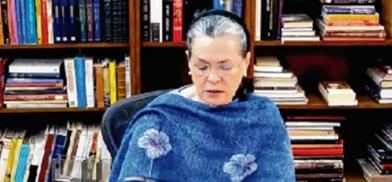Government of China, Chinese Embassy were donors to RGF led by Sonia Gandhi
A startling revelation has come to light that the government of the Peoples Republic of China and the Chinese Embassy in India have been funding the Rajiv Gandhi Foundation (RGF) led by Congress President Sonia Gandhi, reports IANS

A startling revelation has come to light that the government of the Peoples Republic of China and the Chinese Embassy in India have been funding the Rajiv Gandhi Foundation (RGF) led by Congress President Sonia Gandhi, reports IANS. Sonia Gandhi is the Chairperson of RGF, and its board includes former Prime Minister Manmohan Singh, former Congress President Rahul Gandhi, former Finance Minister P. Chidambaram and Congress General Secretary Priyanka Gandhi, among others.
According to an RGF annual report, accessed by IANS, in 2005-06, the Rajiv Gandhi Foundation received a donation from the government of People's Republic of China and the Chinese Embassy as two separate donors. These were listed as donors in the report in the list of general donors.
When contacted, former Finance Minister and RGF Board member P. Chidambaram told IANS, "You should put this question to the Chief Executive."
According to some estimates, the donation was to the tune of $2 million between 2004 and 2006 and $9 million between 2006 and 2013.
Now, leap forward to 2009. The Rajiv Gandhi Institute for Contemporary Studies (RGICS) functions as a think-tank and carries extensive and relevant research on contemporary issues.
As per the RGF annual report, in April 2009, RGICS Fellow Mohammad Saqib carried out a feasibility study, ‘India-China: Free Trade Agreement (FTA)', in association with Purnachandra Rao.
The main objective of the study was to gain a better understanding of an FTA between India and China, analyse various trade issues and identify who would stand to gain and lose from such an agreement. The report concluded that China would be the greater beneficiary in all trade dimensions because of the efficiency of its economy.
"There is a principal need for India to improve its commodity structure to balance its performance of competitiveness and complementarities," the study said.
The authors suggested that India needed, at the minimum, to diversify its products. The study concluded that "there are always losers and gainers in the regional and free trade agreements. India and China can balance the gains and losses through an FTA".
"Therefore both governments should decide to enter into FTA negotiations. The proposed FTA between India and China will be feasible, desirable and mutually beneficial. An FTA between India and China should also be comprehensive, with a free flow of goods, services, investments and capital," said the study advocating an FTA between India and China, which will be beneficial to both the countries.
In June 2010, another similar study was conducted. RGICS researchers undertook a feasibility study on India-China trade sector ties through a possible FTA.
This built on the earlier work carried out during the 2009-10 period, in which RGICS Fellow Mohammad Saqib studied a possible India-China FTA along with Purnachandra Rao.
During the 2010-11 period of the project, the researchers examined trade trends between India and China in order to identify cooperative measures by promoting trade and investment liberalisation facilities, better understand FTAs and forecast future prospects.
The study found China to be more fully integrated into the world economy as a major economic powerhouse than India, in large part because of the comparative advantage of labour surplus. But the study also proposed that an FTA would help bilateral economic relations, and that the free flow of goods, services, investments and capital would in fact benefit India's trade sector more than China's.
Congress critics argue that this study was done despite the admission that China was already benefiting much more than India from the imbalanced trade.
Critics of the Congress are asking whether there is some connection between the donation to the RGF, the Congress party think-tank lobbying for an FTA with China, and allowing the trade deficit to jump 33 times between 2003-04 and 2013-14.
In addition, questions are being posed if this donation to RGF has any connection with the Memorandum of Understanding (MoU) signed between the Congress and the Chinese Communist Party (CCP) in 2008.
There are demands that it is time that the Congress party comes clean on the MoU it signed with the CCP.
There are also demands that the Congress should make full disclosure of its relations with CCP and on the contents of the MoU is essential for the interest of India, as the Congress party is the largest opposition party in India with governments of its own or in alliance in several states.
Critics point out that curiously, India's trade deficit with China starts to balloon thereafter. Overall trade deficit with China increased 33 times, i.e., from $1.1 billion in 2003-04 to $36.2 billion in 2013-14, under the UPA.
After the BJP cornered the Congress on the Rajiv Gandhi Foundation receiving donations from the Chinese Embassy, the Congress responded that "the BJP should stop living in 2005" and alleged that the ruling party is adopting "diversionary tactics" to avoid answering questions on the Chinese transgressions in Ladakh.
Congress chief spokesperson Randeep Surjewala said, "Please stop living in 2005 and start answering questions in 2020".
The Congress countered the BJP on its allegations on RGF, saying "don't adopt diversionary tactics instead of answering the questions raised by the Congress," said Surjewala.
The controversy erupted after BJP alleged that "Donations showed results soon after. RGF did not just one but several studies on how a Free Trade Agreement between India and China is desirable and required. Studies argued that India needs the FTA much more than China and should pursue it as part of its efforts to improve bilateral relations! " said Amit Malviya, head of the BJP's IT cell.
The Congress posed counter questions and asked "Why is the government mum about Chinese presence in eastern Ladakh area, in the national interest the nation wants to know the answer to these questions instead of diversionary tactics of the present BJP government."
Surjewala said "I can ask Prime Minister Narendra Modi and his government, is it not true that the only Chief Minister (as Gujarat CM) who visited China 4 times is none less than Prime Minister Modi, the only Prime Minister who visited China five times is Prime Minister Modi, the only Prime Minister who called the Chinese premier three times is Prime Minister Modi."
"Is it not true that Rashtriya Swayamsevak Sangh held a consultation in 2009 with Chinese Communist Party and did not Rajnath Singh receive and hold a meeting with Chinese delegation in 2008? Is it not true that then BJP President Nitin Gadkari on January 19, 2011, led a delegation to China and held consultations?"
"Are these consultations anti-India? Is it not true that BJP sent a 13-member parliamentary delegation to China to study their political system, were these anti-India activities?" asked Surjewala (IANS)









Post a Comment